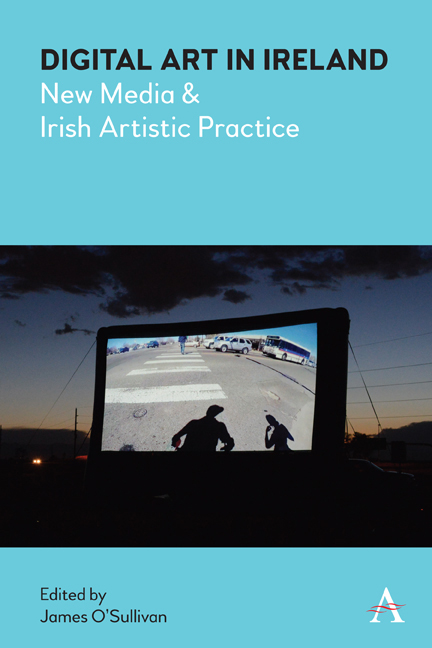Book contents
- Frontmatter
- Dedication
- Contents
- List of Illustrations
- Acknowledgements
- Notes on Contributors
- Chapter 1 Introduction: Digital Art in Ireland
- Chapter 2 Strange Mothers: The Maternal and Contemporary Media Art in Ireland
- Chapter 3 Between Aesthetics and Institutions: Irish Electronic Poetry
- Chapter 4 ‘to shine upon the original all the more fully’: Contemporary New Media Adaptations of James Joyce
- Chapter 5 Art in the Data-City: Critical Data Art in the Age of Surveillance Capitalism
- Chapter 6 Experimental Arcade Video Games as Self-Reflexive Media Art
- Chapter 7 Folding, Unfolding, Refolding Sound Claire Fitch
- Chapter 8 Treacherous Images and Animal Gazes: Ailbhe Ní Bhriain's Reports to an Academy, 2015
- Chapter 9 Pressing Send: Distribution and Curation in Irish New Media Art
- Index
Chapter 5 - Art in the Data-City: Critical Data Art in the Age of Surveillance Capitalism
Published online by Cambridge University Press: 23 February 2022
- Frontmatter
- Dedication
- Contents
- List of Illustrations
- Acknowledgements
- Notes on Contributors
- Chapter 1 Introduction: Digital Art in Ireland
- Chapter 2 Strange Mothers: The Maternal and Contemporary Media Art in Ireland
- Chapter 3 Between Aesthetics and Institutions: Irish Electronic Poetry
- Chapter 4 ‘to shine upon the original all the more fully’: Contemporary New Media Adaptations of James Joyce
- Chapter 5 Art in the Data-City: Critical Data Art in the Age of Surveillance Capitalism
- Chapter 6 Experimental Arcade Video Games as Self-Reflexive Media Art
- Chapter 7 Folding, Unfolding, Refolding Sound Claire Fitch
- Chapter 8 Treacherous Images and Animal Gazes: Ailbhe Ní Bhriain's Reports to an Academy, 2015
- Chapter 9 Pressing Send: Distribution and Curation in Irish New Media Art
- Index
Summary
What is it about data and the city that renders them of particular interest at this moment, and where does media art practice fit in this picture? This journey begins with the city at this moment of emergence, as complex pervasive systems are changing the nature and practice of urban space, extensive data assemblages are coming to being, capturing almost every digitally mediated action resulting in complex and unpredictable outcomes. This includes not only the movement and actions of city dwellers but also their hopes and desires, all faithfully self-recorded by what may be termed human sensors, equipped with networked location-aware and socially connected mobile devices. While the interaction of humans and non-human actors have always produced the space of the city, the digital revolution has changed the nature and extent of these interactions, with the data revolution now rendering it all as data.
We increasingly live in smart cities (Townsend 2013; Picon 2015), cities that are entangled in networks, enmeshed in coded infrastructure with almost every activity producing data. Complex networked assemblages of digital technologies and Information and communications technology infrastructure manage urban systems (Kitchin and Dodge 2011) and can be thought of as producing the space of the city automatically (Thrift and French 2002). High-speed network connectivity has become an infrastructural requirement deemed as essential as power and transport (Mattern 2015), while ubiquitous computing networks (Weiser 1991) build computing power into the very fabric of the city with even the most mundane objects networked as part of the internet of things. Extensive sensor networks are emerging that have the ability to collect and transmit real-time data on myriad operational and quality-of-life parameters (e.g. noise levels, air quality and water levels) which are fed back into algorithmically controlled decision-making systems (we are even beginning to see city operating systems such as City-OS in Barcelona) with live feeds of data increasingly being made available to citizens through city dashboards (examples include the Dublin, London and New York city dashboards). These official sensor networks are supplemented with, and often contested by, citizen-sensing networks using low-cost electronics to monitor environmental parameters, such as air quality, at a localised level with data collected through smart phones and shared in cloud-based data repositories.
- Type
- Chapter
- Information
- Digital Art in IrelandNew Media and Irish Artistic Practice, pp. 71 - 90Publisher: Anthem PressPrint publication year: 2021



